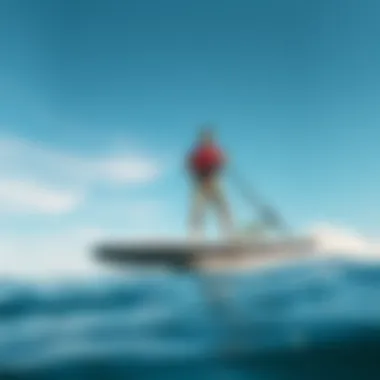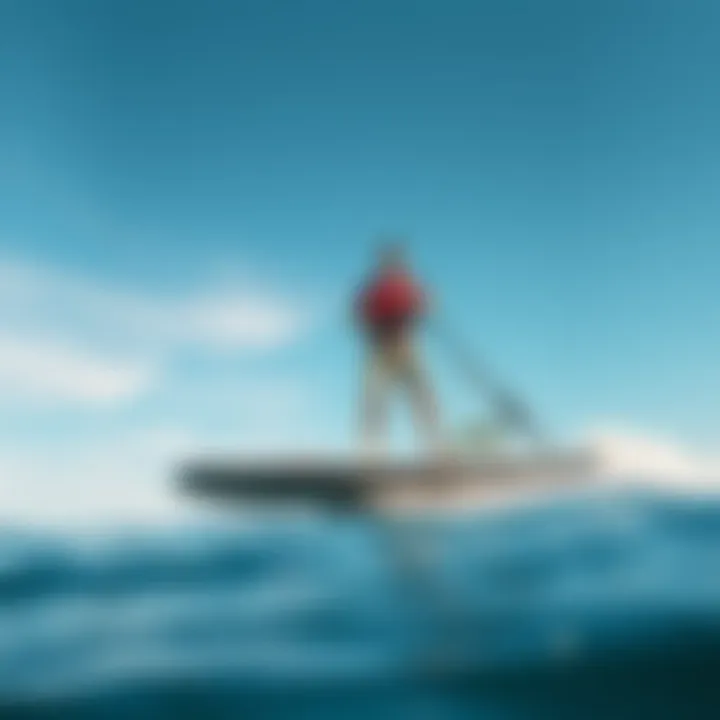Exploring Stand-Up Hydrofoiling: A New Wave in Water Sports


Intro
The world of water sports is a vibrant tapestry woven from threads of innovation, thrill, and camaraderie. Among the most intriguing developments in recent years is stand-up hydrofoiling, a sport where riders glide above the surface of the water, propelled by a submerged hydrofoil. Not only does this technique provide a unique way to experience water sports, but it also opens up a dialogue about skill, technology, and environmental awareness.
Hydrofoiling involves a setup where a board is attached to a foil—which is essentially a wing—beneath the water’s surface. As speed builds, the foil lifts the board above the water, allowing for a smoother ride and less resistance. This isn’t just about the exhilarating sensation of flying over water; it’s about understanding the delicate balance between nature and technology.
This article promises a deep dive into the mechanics, benefits, and nuances of stand-up hydrofoiling. We will explore how it intersects with the burgeoning kiteboarding community, discuss gear and safety, and provide practical tips for beginners and seasoned riders alike. In a world where water sport enthusiasts constantly seek the next adventure, understanding hydrofoiling is crucial for staying ahead of the curve.
By dissecting these aspects, the aim is to not only inform but inspire. Each section will contribute to a broader comprehension of this innovative sport, addressing its significance and potential hazards. Let’s cut through the waves and get started.
Prelims to Stand-Up Hydrofoiling
Understanding stand-up hydrofoiling is essential in the realm of modern water sports, as it represents a unique blend of technology, skill, and outdoor adventure. Hydrofoiling distinguishes itself not only through its exhilarating experience of gliding above water but also through the intricate mechanics that allow this feat. Enthusiasts are drawn to the responsive nature of hydrofoils; they experience a profound connection with both equipment and element. The discussion will delve into these elements, highlighting both the appeal and complexity of this innovative sport.
One of the standout benefits of hydrofoiling is its efficiency; when the foil lifts above the water, the drag diminishes significantly, allowing for a smoother and faster ride. This setup minimizes physical exertion while maximizing speed, much to the delight of adrenaline seekers. Furthermore, the unique perspective gained from atop a hydrofoil allows riders to engage with their environment in ways that traditional water sports simply can’t offer.
However, with innovation comes the necessity for understanding; there are also considerations such as the learning curve involved and the technical aspects of maintaining control during maneuvering. Riders often find that mastering hydrofoiling is not merely a trial-and-error endeavor, but one that requires patience and dedication. Yet, once those hurdles are cleared, the euphoria of gliding above the water can feel profoundly rewarding.
This section will explore the fundamental definitions and historical contexts of hydrofoiling, paving the way for a deeper appreciation of its nuances. Recognizing where it came from offers insights into how it evolved into a sport that is not only thrilling but also steeped in connection with the ocean and wind.
Defining Hydrofoiling
At its core, hydrofoiling is the act of using underwater wings, or foils, to lift a watercraft above the surface. This separation from the water enables significantly reduced drag, facilitating faster speeds and greater agility. The basic structure of a hydrofoil consists of a mast, fuselage, and one or two wings (or foils) that protrude underwater. When in motion, the lift generated by these wings counters the weight of the rider and the board, propelling the rider into the air above the surface.
This technique is often compared to the way an airplane wing generates lift through its shape and angle; as the hydrofoil moves forwards, water flows over the wings, creating a pressure difference that lifts the board upward. Despite its technical formation, the sensation of riding a hydrofoil often aligns with intuition and an innate understanding of balance.
The appeal lies in the combination of thrill and tranquility—it’s a dance with nature. Riders describe the experience as a smooth glide over the water, feeling more akin to flying than anything else. The feeling is undeniably addictive for those who have embraced the sport.
Historical Context and Evolution
The origins of hydrofoiling stretch back several decades. The concept first emerged in the 1960s, credited largely to inventor and innovator Bob Wood, who crafted the first hydrofoil surfboards. However, it wasn’t until the late 1990s and early 2000s that advances in materials and design began to increase the popularity of hydrofoil boards. Innovations like carbon fiber construction brought strength and reduced weight, making it feasible for more riders.
As kiteboarding surged in popularity, so too did hydrofoiling, allowing for the exhilarating thrill of catching air with the support of a kite. This evolution reflects broader trends in watersports that prioritize speed, efficiency, and accessibility. With a burgeoning community around it, hydrofoiling has become a staple in various water sports, including kiteboarding and wakeboarding, to mention a couple.
Today, hydrofoiling stands at the cutting edge of water sports, continually adapting and evolving. With a range of designs available, from small beginner boards to high-performance racing foils, the sport also creates a welcoming entry point for newcomers. This journey from niche innovation to mainstream acceptance highlights its exciting trajectory and the growing respect it garners in the world of extreme sports.
Hydrofilling aims not just to thrill but to immerse riders in the elements—in harnesing the wind and waves.
In understanding its definition and historical roots, we see the journey hydrofoiling has taken and appreciate its remarkable capacity to captivate adventurous spirits.
The Physics of Hydrofoils
The intricate dance between water and board during stand-up hydrofoiling begs a thorough understanding of its underlying physics. Hydrofoils lift riders above the water’s surface, offering a smoother, more exhilarating ride compared to traditional methods. When we peel back the layers of physics in hydrofoils, we not only grasp how this innovative sport functions but also appreciate its unique appeal and potential risks.
Understanding Lift and Drag
When you think about hydrofoils, envision a bird soaring through the sky. Just like wings create lift for birds, hydrofoils generate lift for riders. Lift, in essence, is the upward force that counterbalances the weight of the board and rider. The hydrofoil’s wing shape is designed meticulously, often resembling an airplane wing, taking into account the necessary angle and surface area to optimize this force. As the board accelerates, a pressure difference forms above and below the foil. Higher pressure underneath the foil pushes it up, enabling the rider to glide above the water, reducing drag significantly.
However, drag works in tandem with lift and is equally crucial in this dance of physics. Think of it as the resistance you feel when walking against the wind; it’s the friction with water that needs to be minimized for an efficient ride. There are two types of drag to consider: parasitic drag, which arises from the shape of the foil and the board, and induced drag, which occurs when lift is generated. By fine-tuning the shape and material of hydrofoils, manufacturers aim to reduce these forces. One key takeaway for riders is that a better understanding of lift and drag directly influences performance.
"The key to successful hydrofoiling lies in mastering the relationship between lift and drag; it’s all about finding the sweet spot.’’
Hydrodynamic Principles Explained
Understanding the hydrodynamics involved in hydrofoiling is akin to grasping how ships navigate vast oceans. The principles governing how objects move in water, including buoyancy and flow, are central to the experience. Buoyancy, the upward force that the liquid exerts, plays a critical role in the feasibility of hydrofoiling. The placement of the hydrofoil beneath the waterline and its geometric design actively influences how buoyancy interacts with the hydrodynamic forces.
Flow dynamics, or how water moves around the hydrofoil, determines not only efficiency but also stability. Speed is a significant factor; at slower speeds, riders may find themselves struggling to break through the water's surface tension. As speed increases, the flow turns laminar and reduces turbulence, leading to more stable and predictable rides. Each wave or ripple can change the dynamics for a rider, meaning that they must constantly adapt their techniques.


Riders should be aware that their position and weight distribution on the board can greatly affect the hydrofoil's performance. Leaning too far back or forward can create unnecessary drag, jeopardizing lift and overall ride quality. This fine balance between understanding physics and personal technique is where many riders find both challenge and satisfaction.
For those keen to delve deeper into these principles, resources like the American Institute of Aeronautics and Astronautics or Hydrofoils in Marine Systems offer extensive insights into hydrofoil dynamics.
In summary, grasping the physics behind hydrofoils—lift, drag, and hydrodynamic principles—guides both novices and seasoned riders toward maximizing their potential on the water. This foundation opens the door to exploring advanced techniques that will ensure an exhilarating experience.
Stand-Up vs. Traditional Techniques
Hydrofoiling, while gaining traction in the watersport community, presents a striking contrast to traditional surfing and kiteboarding. To fully understand the appeal of stand-up hydrofoiling, one must consider the fundamental differences between these techniques. The blend of technology, skill, and the unique experience it offers places it in a category all its own. Not only does it put a different spin on water sports, but it also demands a reevaluation of approaches that athletes have relied on for years.
Comparative Analysis of Techniques
When diving into the core elements of stand-up hydrofoiling versus traditional techniques, we find that both have their own charms and challenges. Here are some key points of differentiation:
- Technique and Stance: In traditional surfing, athletes typically ride on the surface, relying on the power of waves. In contrast, stand-up hydrofoiling allows the rider to elevate above the water's surface, considerably changing the dynamics.
- Speed and Fluidity: Hydrofoiling grants the user the ability to reach speeds greater than what’s achievable on a regular surfboard. This is mainly because of reduced drag as the board is lifted. It must be noted, however, that initial learning might feel quite sluggish, due to the need for balance and rhythm.
- Equipment Complexity: Traditional setups involve a board and perhaps a leash, while hydrofoiling requires an intricate assembly of the foil, which includes wings and masts. Understanding how each component interacts to generate lift takes time and careful consideration.
- Adaptability to Conditions: Hydrofoiling is often more adaptable to various conditions than traditional riding. It allows athletes to catch smaller and less powerful waves by lifting off the water.
The ability of riders to glide over the surface opens a new life to waves that would otherwise go unnoticed.
These aspects contribute to a broader experience that is both exhilarating and, at times, daunting. Hydrofoiling is not merely a new technique but rather a realm that can potentially redefine how water sports are approached.
Learning Curve and Skill Development
Embarking on the journey of stand-up hydrofoiling isn’t a stroll in the park. The learning curve associated with mastering hydrofoil techniques can serve as both a hindrance and an incentive. While seasoned surfers might find the transition easier, beginners often grapple with the complexities involved.
- Balance and Coordination: Essential for all watersports, hydrofoiling takes this to another level. Maintaining stability on the foil requires keen body awareness and coordination. Riders must gain experience figuring out how to shift weight effectively to avoid crashing into the water.
- Understanding Foiling Mechanics: It’s crucial to grasp how lift works under the foil and the nuances of controlling the foil's elevation. This isn’t something that comes overnight and may take several sessions to even start feeling comfortable.
- Progressive Skill Levels: Most riders will begin with short sessions, often only managing to lift for a few seconds at a time. As experience builds, riders gradually develop the possibilities for more complex maneuvers like turns or jumps.
Gear and Equipment Essentials
When it comes to stand-up hydrofoiling, having the right gear isn't just a recommendation; it's the bedrock upon which skill and enjoyment are built. In every sport, the tools of the trade can determine not only performance but safety as well. Hydrofoiling requires specific equipment designed to enhance the experience and manage the unique challenges that come with gliding above the water.
Hydrofoil Components Breakdown
Foil Assembly
In hydrofoiling, the foil assembly is a critical player. Comprising the mast, wings, and fuselage, this component lifts the board out of the water. The key characteristic of foil assembly is its ability to create lift, allowing riders to experience the thrill of flying above the waves. A longer mast is generally favored for more significant lift and stability; however, it may take some getting used to, especially for novices. On the flip side, shorter masts might be easier for beginners to manage, but they limit lift.
A unique feature of foil assemblies is their adjustability. This aspect allows riders to configure their setup according to personal skill levels. Advantages include increased performance in various conditions, yet one should also be aware of the disadvantage of needing more expertise to handle complex setups. Riders often have to tinker with adjustments to find what suits them best.
Board Selection
Choosing the right board is akin to finding the perfect dance partner—fitting your style is crucial. Boards designed for hydrofoiling often feature a distinct shape with a wider base and a hydrodynamic outline. A key characteristic of good hydrofoil boards is their lightweight construction, which aids in maneuverability. Materials like carbon fiber or lightweight composites often see usage here, allowing for easier handling and better performance.
What makes board selection interesting is the variety it offers. Some boards cater more to speed, while others focus on stability and ease of control. With the right board, riders can find advantages in agility and responsiveness on the water, yet choosing an inappropriate board might lead to difficulties during starts or turns.
Safety Gear
Safety is a priority in any adventurous sport, and hydrofoiling is no exception. Proper safety gear is non-negotiable; it not only helps to prevent injuries but contributes to overall confidence on the water. A critical characteristic of safety gear includes impact vests, helmets, and even specialized hydration bags for long sessions. These pieces are designed to protect vital areas while giving riders peace of mind.
The unique feature of safety gear in hydrofoiling is its specialization compared to other water sports. Many users tend to favor multi-purpose items which can lead to gaps in safety protection. Investing in dedicated hydrofoil safety gear can make a significant difference in minimizing risks, while failing to take this seriously can result in injuries that detract from the fun.
Choosing the Right Setup
Selecting the right setup can make one feel like a kitesurfer auditioning for a high-stakes show. It's not just about assembling the parts; it’s about synergy. Factors such as water conditions, the rider's weight, and skill level should all factor in when determining the right configuration.
Understanding how each piece complements the others is key. For instance, the height of the mast may need to be adjusted according to the wind and waves on the day of the ride. Ensuring that your foil, board, and safety gear align with one another can be the difference between an exhilarating session and a regrettable outing.
Overall, navigating the world of hydrofoiling gear requires a blend of knowledge, experience, and, most importantly, an eye for what fits one’s personal riding style. Each component, from the foil assembly to the board and safety gear, plays a pivotal role and cumulatively enhances the rider’s experience on the water. Therefore, taking the time to find the right setup will pay off, leaving the rider buoyed by the adrenaline of hydrofoiling.


“Gear is important, but it’s the rider’s finesse that truly makes the difference.”
Techniques for Successful Hydrofoiling
The realm of hydrofoiling is not just about the thrill of gliding above the waves, it's also about mastering a set of techniques that allow a rider to enjoy this unique experience fully. Techniques for successful hydrofoiling can significantly alter one’s interaction with the water and contribute to overall enjoyment and safety. No one wants to feel like a fish out of water on their board, so understanding these techniques is crucial for both fun and longevity in the sport.
Starting Off: Initial Steps
Stepping onto a hydrofoil board for the first time can be akin to learning to ride a bicycle. There's a bit of wobbling at first, balancing the board while finding your footing can feel like a tricky dance. It’s essential to start in shallow and calm waters. Here are some steps to kick off your hydrofoiling adventure:
- Get Familiar with Your Equipment: Before hitting the water, ensure you understand your hydrofoil's components. Familiarize yourself with the board, the foil, and how they interact.
- Stable Stance: Adopt a shoulder-width stance with your knees slightly bent. This will help you maintain balance as you get used to the rising sensation when the foil lifts out of the water.
- Small and Gradual Movements: Initially, lean gently on the front of the board to lift the foil, and don't be shy about shifting your weight back if needed. Mastering this balance takes a bit of time.
- Practice Falling: Falling off is part of the learning process. It’s good to fall gracefully by keeping your legs bent and your arms close to your body.
Practicing these initial steps will help build your confidence and improve your comfort level on the water.
Maintaining Foil Control
Once you've mastered the initial takeoff, the real challenge lies in controlling the foil while riding. Having good foil control means you can enjoy smoother rides and avoid potential wipeouts. Here are some considerations to master this art:
- Weight Distribution: Shift your weight smoothly and consistently between your feet. The key to balance in hydrofoiling is not overthinking it. Make your movements feel instinctual.
- Body Positioning: Keep your upper body relaxed while maintaining a slightly inclined posture forward. This helps manage the lift while minimizing unnecessary movements.
- Anticipating Conditions: Watch for choppy water and unpredictable winds. Being able to read the water like a book can make all the difference. Adjust your body position according to the environment, as water conditions can change quickly.
If you find yourself losing balance, rather than panicking, try recalibrating by focusing on your breathing and body alignment. With practice, maintaining control over the foil will feel more intuitive.
Advanced Maneuvers in Hydrofoiling
For those who have a firm grasp on the fundamentals, exploring advanced maneuvers can be incredibly rewarding. It adds dimensions to your riding and shows off your skill. Here are some advanced techniques you might explore:
- Jumps and Tricks: Once comfortable, consider practicing jumps. Begin with small hops off the water, gradually increasing your height as confidence builds.
- Turning Techniques: Mastering hard turns or carving requires understanding how to manage speed and weight distribution. It can also be beneficial to practice in a controlled area before attempting rapid turns at speed.
- Riding Switch: This involves switching your stance while riding. It enhances overall balance and makes you a more versatile rider in challenging conditions.
Learning advanced maneuvers is like unlocking levels in a game. Each new skill you master opens doors to even more excitement and possibilities in the sport.
Practicing these advanced techniques will vastly improve your performance and enjoyment of hydrofoiling, allowing you to stand out not just as a participant, but as an artful technician on the water.
Safety Considerations
Safety is paramount when venturing into the thrilling realm of stand-up hydrofoiling. Engaging with this sport not only tests your skills and balance, it also demands a keen understanding of the safety protocols needed to ensure a safe experience on the water. This section delves into the aspects of risk assessment and the significance of the right safety gear.
Risk Assessment in Hydrofoiling
Before hitting the waves, it's essential to evaluate the risks associated with hydrofoiling. First off, the learning curve can be steep, with many beginners facing the possibility of falls. While most water sports come with their share of spills, the dynamic nature of hydrofoiling adds a layer of unpredictability. Here are several important risk factors to consider:
- Environmental Conditions: Wind speed, water currents, and wave height can change rapidly, so being aware of the local weather conditions is crucial. If the water looks choppy or the wind is inconsistent, it might be wise to sit this one out.
- Collisions: Unlike traditional kiteboarding, hydrofoilers operate above the water surface, which can lead to unintentional interactions with other water users. Always keep a safe distance and maintain situational awareness to avoid accidents.
- Fatigue: Hydrofoiling can be physically demanding, and fatigue can impair your judgement and reaction times. It’s vital to listen to your body and know when to take a break.
"A prudent sailor never disregards the whispers of the wind, nor the mood of the sea."
- An age-old maritime adage that rings true, especially in hydrofoiling.
Safety Gear Importance
When it comes to hydrofoiling, investing in the right safety gear can make all the difference. Here’s a breakdown of essential equipment:
- Helmet: Protecting your head should be the top priority. A good quality helmet can shield against accidental falls and bumps, which are common during learning sessions.
- Impact Vest: These vests provide not only buoyancy but also protection against potential impact with water surface or gear. They can offer peace of mind as you experiment with new tricks.
- Safety Leash: A safety leash connects you to the board. If you fall, it prevents the board from drifting away and possibly causing injuries or accidents.
In addition to protective equipment, embracing safety practices is key. Making sure to practice in designated areas, informing someone about your plans, and considering a buddy system can all contribute to a safer experience. Engaging with the hydrofoiling community, like those found on platforms such as Reddit, can provide insights and tips to enhance your safety awareness further.
Ultimately, while stand-up hydrofoiling promises exhilaration and freedom, understanding safety considerations allows you to relish each moment without unnecessary risks. Proper risk assessment and the right gear can elevate your experience while ensuring you remain safe on the waters.
Environmental Impact and Awareness


The conversation around environmental impact is crucial in today’s water sports scene, particularly with innovations like stand-up hydrofoiling. As this sport grows in popularity, so does the need for awareness regarding its ecological footprint. Stand-up hydrofoiling, while exhilarating, necessitates a close examination of its effects on marine environments and ecosystems. The increasing number of enthusiasts and riders can inadvertently lead to disturbances in sensitive habitats, pushing us to consider responsible practices that protect our watery playgrounds.
Hydrofoiling and Marine Life
Hydrofoiling often takes place in areas known for their rich and diverse marine life. From gentle dolphins swimming alongside riders to vibrant coral reefs that attract snorkelers, these ecosystems are delicate and deserve our attention. The sound made by hydrofoil boards can startle marine creatures, leading to displacement and altered behaviors.
Key Considerations:
- Birds and Marine Mammals: Birds might be less inclined to fish in zones frequented by hydrofoilers, disrupting their feeding habits. Likewise, species such as seals or sea lions might retreat from these areas, impacting their population dynamics.
- Coral Reefs and Seagrass: Many hydrofoiling enthusiasts often engage in thrilling pursuits near coral reefs and seagrass beds. However, the potential for accidental collisions or dragging the foil across these habitats can lead to significant damage.
- Us vs. Them Mentality: With increasing numbers participating in the sport, we must swap ‘us versus them’ mentalities for a more inclusive approach that recognizes we share these waters with countless marine inhabitants.
Encouraging positive interactions with marine life reinforces a deeper appreciation for the environments we enjoy. Riders should remain educated about the areas they frequent, ensuring their hobbies align with marine conservation efforts.
Sustainable Practices in the Sport
To promote sustainable practices in stand-up hydrofoiling, the community must take a proactive stance in minimizing its ecological impact. Many riders are already making strides to adopt environmentally friendly habits that safeguard our aquatic ecosystems.
Recommended Practices:
- Respect Wildlife: Always monitor your proximity to marine creatures. Maintaining distance helps prevent undue stress on animals just trying to live their lives.
- Gear Selection: Consider investing in eco-friendly or sustainably produced gear. Some brands focus on natural materials and sustainable manufacturing processes. Look for options that utilize recycled materials to lessen the environmental burden.
- Educating Others: Sharing insights and knowledge on sustainable practices can encourage others within the community to embrace similar behaviors. Host workshops or engage on social media platforms to raise awareness on preserving marine environments.
- Cleaning Up: A personal commitment to action, such as organizing beach sweeps or clean-up events, helps tackle pollution directly. Leaving the beach cleaner than you found it helps cultivate an environment where both humans and marine life thrive.
"Protecting our waters is a responsibility all water enthusiasts should embrace. Every action counts, no matter how small."
In sum, the future of stand-up hydrofoiling entwines with the health of our waters and ecosystems. By nurturing awareness of our environmental impact and adjusting our practices accordingly, we can ensure that this thrilling sport continues to coexist with nature for many generations to come. It’s our shared duty to strike a balance between adventure and accountability.
Future of Hydrofoiling in Kiteboarding
The future of hydrofoiling in kiteboarding represents not just a trend, but a pivotal shift in the landscape of water sports. As the sport continues to evolve, several key elements and benefits emerge, shaping the experience for participants and enthusiasts alike. This transformation is characterized by advancements in technology, growing community engagement, and a focus on sustainable practices, proving that hydrofoiling is not just a passing fancy but a significant component of the kitesurfing world.
Innovations on the Horizon
The technological advancements in hydrofoiling gear are remarkable. Manufacturers are continuously refining hydrofoil designs to enhance performance and user-friendliness. For instance, the introduction of lightweight materials like carbon fiber has led to significant reductions in board weight without compromising durability. Riders now have access to customizable gear, allowing for a tailor-made experience suited to individual preferences and skill levels.
Moreover, we’re seeing improvements in electric hydrofoils, or e-foils, which add a whole new layer of excitement and accessibility to the sport. These devices, equipped with silent electric motors, enable users to experience gliding above the water without relying solely on wind conditions. This opens up hydrofoiling to a broader audience, including those in regions where kiteboarding is less viable due to inconsistent winds.
As inventive ideas continue to surface, the incorporation of responsive designs also promises to enhance learning. New tech features, such as adjustable foil angles, can assist beginners in stabilizing as they learn the ropes. When combined with user-friendly tutorials available online, innovations pave the way for a smoother learning curve in hydrofoiling.
Expanding Community and Events
The community surrounding hydrofoiling is not just growing; it’s thriving. Enthusiasts from diverse backgrounds are uniting, creating an inclusive atmosphere that fosters shared experiences. Local and national competitions have started featuring hydrofoiling events, gaining attention and excitement. This expansion has introduced a lively atmosphere that encourages participation and skill development.
The rise of online platforms and social media groups amplifies this sense of community. Platforms like Reddit, Facebook, and Instagram serve as gathering places for riders to exchange tips, showcase achievements, and promote upcoming events. Through these channels, newcomers can receive support and advice from seasoned riders, effectively building networks that transcend geographical boundaries.
Local shops are also jumping on the bandwagon, hosting meetups and workshops focused on hydrofoiling. This hands-on approach helps foster relationships among kiteboarders while providing essential education on gear maintenance and safety practices. Coupled with grassroots events, these gatherings nurture a passionate community keen on sharing the thrills of hydrofoiling.
In summary, as hydrofoiling in kiteboarding continues to make waves, the symbiotic relationship between technological advancements and community engagement will drive the sport into the future. Innovators at the helm, coupled with a motivated community, will ensure that hydrofoiling remains an exciting and inclusive venture for everyone, from the curious beginner to the seasoned pro.
End
As we've journeyed through the intricacies of stand-up hydrofoiling, we arrive at a pivotal point of reflection. This conclusion doesn’t merely summarize the subject; it encapsulates the significance of hydrofoiling in the context of water sports. Understanding what makes hydrofoiling unique allows enthusiasts to appreciate its nuances and intricacies fully.
Summation of Key Points
To reiterate, the exploration of hydrofoiling has unveiled various essential elements:
- Mechanical Principles: The physics of hydrofoiling, particularly lift and drag dynamics, serve as the backbone of how this sport functions on the water.
- Techniques and Skills: From learning initial starts to mastering advanced maneuvers, the learning curve in hydrofoiling is distinct yet rewarding. This diversity caters to various skill levels, encouraging both novices and experts.
- Environmental Mindfulness: Engagement with marine life and sustainable practices is essential for the sport's longevity and its community's health.
- Community Growth: As hydrofoiling continues to gain traction, the expanding networks of events and exploration foster a sense of camaraderie among practitioners.
Moreover, the article has highlighted not just how to become a proficient hydrofoiler, but also ways to engage thoughtfully with the environment and community around this sport. These points are not mere facts; they represent the fabric that weaves together the hydrofoiling experience.
Final Thoughts on Hydrofoiling's Role
In the grand tapestry of water sports, hydrofoiling stands as a testament to human ingenuity and the relentless pursuit of thrill. The unique sensations offered by gliding above the water's surface add a layer of excitement while simultaneously presenting challenges that require dedication and skill. The cross-pollination between hydrofoiling and kiteboarding illustrates how innovation continues to reshape recreational activities.
Moreover, the understanding that comes with mastery of hydrofoiling extends beyond just technique. It involves a deeper respect for the environments we enjoy and supports a spirit of adventure that can inspire forthcoming generations. The journey of every hydrofoiler adds to the rich history and ongoing narrative of water sports.
Ultimately, adopting and promoting sustainable practices within this captivating realm assures that hydrofoiling can be enjoyed by enthusiasts of all ages for years to come. As this sport develops, its role in fostering community, awareness, and innovation will undoubtedly solidify its place in the future of adventure sports.



